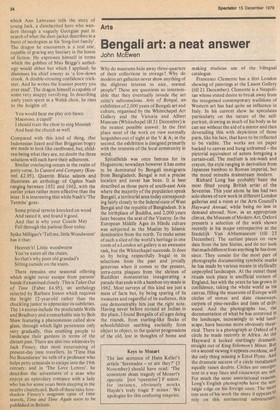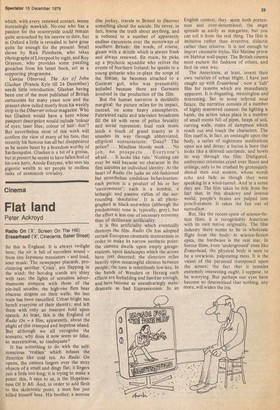Bengali art: a neat answer
John McEwen
Why do museums hide away three-quarters of their collections in storage? Why do modern art galleries never show anything of the slightest interest to nice, normal people? These are questions so interminable that they eventually invade the art critic's subconscious. Arts of Bengal, an, exhibition of 2,000 years of Bengali art and culture, organised by the Whitechapel Art Gallery and the Victoria and Albert Museum (Whitechapel till 31 December) is the neatest possible answer. In the first place most of the work on view normally languishes out of sight at the V & A; in the second, the exhibition is designed primarily with the interests of the local community in mind.
Spitalfields was once famous for its Huguenots; nowadays however it has come to be dominated by Bengali immigrants from Bangladesh. Bengal is not a precise location and never has been, It is best described as those parts of south-east Asia where the majority of the population speak Bengali, a territorial area today corresponding fairly closely to the federal state of West Bengal and the republic of Bangladesh. It is the birthplace of Buddha, and 2,000 years later became the seat of the Viceroy. In the European Middle Ages its Hindu culture was subjected to the Muslim by Islamic domination from the north. To make sense of such a slice of the world's heritage in one room of a London art gallery is an awesome task, but the Whitechapel succeeds, It does so by being respectfully frugal in its selections from the past and jovially generous when it comes to the present, terra-cotta plaques from the shrines of Buddhist monasteries inaugurating a parade that ends with a bamboo toy made in 1962. Most surveys of this kind are just a mess of facts but, by being sparing of its treasures and regardful of its audience, this one demonstrably hits just the right note. Having never before noticed an Indian in the place, I found Bengalis of all ages doing the rounds, from starling-like flocks of schoolchildren seething excitedly from object to object, to the quieter progressions of the old, lost in thoughts of home and making studious use of the bilingual catalogue.
Francesco Clemente has a first London showing of paintings at the Lisson Gallery (till 21 December). Clemente is a Neapolitan whose stated desire to break away from the recognised contemporary traditions of Western art has had quite an influence in Italy. In his current show he speculates particularly on the nature of the selfportrait, drawing as much of his body as he can see without the aid of a mirror and then dovetailing this with depictions of those parts, like his face, that have to be reflected to be visible. The works are on paper backed to canvas and hung unframed — the pictorial equivalent of actors foregoing a curtain-call. The medium is ink-wash and crayon, the style ranging in derivation from Japanese bamboo to Roman imperial, but the mood remains mainstream modern.
Richard Long has probably been the most feted young British artist of the Seventies. This year alone he has had two solo shows of new work in different London galleries and a room at the Arts Council's Hayward Annual, while being no less in demand abroad. Now, as an appropriate climax, the Museum of Modern Art, Oxford presents a selection of the work shown recently in his major retrospective at the Stedelijk Van Abbemuseum (till 23 December). The earliest pieces on view date from the late Sixties, and do not look that much different from anything he has done since. They consist for the most part of photographs documenting symbolic marks he has made by various means in idyllically unpeopled landscapes. At the outset thesp rituals took place in unofficial corners of England, but with the years he has grown in confidence, taking the whole world as his canvas, filling the museums of Europe with circles of stones and slate causeways, carpets of pine-needles and lines of drift wood. And the photographs too, the documentation of what he has contrived in the landscape, increasingly in wild land scape, have become more obviously theae. rical. There is a photograph at Oxford of i3 circle he made recently in Africa. At the Hayward it looked startlingly dramatic, straight out of King Solomon's Mines, But on a second viewing it appears overdone, as if the only thing missing is Errol Flynn. And the dramatic success of a circle installatico equally raises doubts. Circles are omnipo tent in a way lines and causeways are not' • For much the same associational reasons, Long's English photographs have the nos talgic edge on his foreign ones. The more one sees of his work the more it appears to rely on this sentimental substructure, which, with every renewed contact, seems increasingly mawkish. No-one who has a passion for the countryside could remain quite untouched by his oeuvre to date, but at Oxford a little is revealed to have gone quite far enough for the present. Small shows by Rick Florsheim, who takes photographs of Liverpool by night, and Roy Grayson, who provides some puzzling gouaches from his latest book, act as a supporting programme. Genius Observed, The Art of John Glashan (Francis Kyle till 24 December) needs little introduction, Glashan having been one of the most published of British cartoonists for many years now and the present show culled mostly from his weekly strip in the Observer colour magazine. Who but Glashan would have a hero whose passport description would include `colour of eyes; laser blue; colour of hair: dun"? But nevertheless most of this work will confirm the view of many of his fans, that recently his humour has all hut disappeared as he seems beset by a boredom worthy of Sardanapalus. Glashan is a bit of a genius, but at present he seems to have fallen foul of his own hero, Anode Enzyme, who uses his gigantic wealth to set people to endless tasks of mammoth triviality.



































 Previous page
Previous page